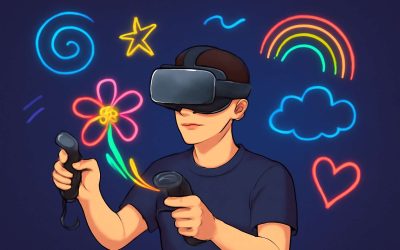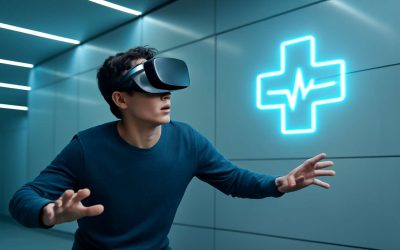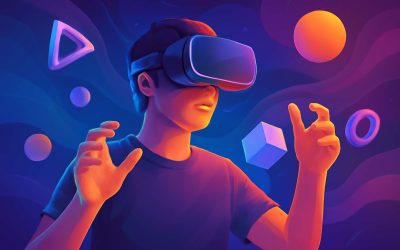Understanding Virtual Reality Logos
Definition and Importance – What is a virtual reality logo and why it matters for VR brands
In the rapidly evolving universe of digital branding, the virtual reality logo stands out as a beacon of innovation. It’s not just a pretty picture; it’s a visual handshake with your audience that signals you’re riding the wave of cutting-edge technology. For VR brands, a virtual reality logo isn’t merely decorative—it’s a strategic asset, encapsulating the essence of immersive experiences and futuristic ambitions.
Think of a virtual reality logo as the visual DNA of your brand in the metaverse. It’s designed to evoke curiosity and convey a sense of limitless potential, inviting users into a world where boundaries blur and possibilities multiply. Its importance is underscored by the fact that in a crowded market, a compelling virtual reality logo can make your brand instantly recognizable and memorable amidst the digital chaos.
To put it simply, a virtual reality logo matters because it’s the first impression in an arena where visual cues drive engagement. Whether it’s a sleek, minimalist emblem or a complex, layered symbol, your virtual reality logo should reflect your brand’s core ethos while resonating within the immersive environments of VR. After all, in a space where perceptions are everything, your virtual reality logo is your calling card—bold, innovative, and unmistakably yours.
Evolution of VR Branding – Historical overview of branding in virtual reality industries
The evolution of branding within the virtual reality industry has been nothing short of revolutionary. As immersive experiences gained momentum, so did the need for a visual identity that could encapsulate this new frontier. Early VR ventures relied on simple symbols—basic icons and minimalistic logos—to establish initial recognition. Over time, however, the virtual reality logo has transformed into a complex tapestry of symbolism, designed to evoke curiosity and convey a sense of limitless potential.
In the nascent stages, branding was primarily focused on establishing a presence—often through straightforward, recognizable logos. As VR technology matured, brands began exploring more layered and dynamic visual identities, paving the way for sophisticated virtual reality logo designs. This shift reflects a broader trend toward immersive branding, where logos are not just static images but become active parts of the virtual experience. Today, the virtual reality logo is a strategic tool that bridges the gap between digital innovation and human perception.
To better understand this progression, consider the following milestones in VR branding:
- Initial logo concepts focused on basic shapes to symbolize virtual environments.
- Introduction of more intricate designs to represent layered, immersive experiences.
- The rise of animated and interactive logos within VR platforms, enhancing user engagement.
This historical overview highlights how the virtual reality logo has evolved from simple identifiers to powerful symbols of futuristic ambitions. It’s a visual language that continues to adapt, reflecting the rapid pace of innovation in the VR industry—an industry where every pixel, every symbol, carries the weight of endless possibilities.
Key Elements of a Successful VR Logo – Design components that make a VR logo effective
A virtual reality logo is more than just a pretty face; it’s the digital handshake that invites users into a brand’s immersive universe. The key to a successful VR logo lies in its ability to encapsulate the essence of innovation while remaining memorable amidst a sea of pixels and virtual landscapes. Effective design components include a harmonious blend of simplicity and complexity—balancing recognizable shapes with layered symbolism that hints at limitless potential.
In the realm of virtual reality logo design, adaptability is paramount. A logo that works seamlessly across static screens and dynamic, interactive VR environments gains a competitive edge. Think of it as a visual ambassador—one that must be versatile yet distinctive. When crafting a VR logo, consider elements like bold color schemes, sleek geometric forms, and subtle animations that evoke curiosity and engagement.
To elevate a virtual reality logo beyond the mundane, some brands incorporate
- interactivity
- animated components
- intricate detailing
that reflect the layered nature of virtual experiences. These design components don’t just catch the eye—they tell a story and forge an emotional connection. After all, in the age of virtual reality, your logo should be a portal—an entry point into a universe where imagination knows no bounds.
Design Principles for Virtual Reality Logos
Futuristic and Innovative Aesthetics – Creating a forward-looking and tech-savvy appearance
Designing a virtual reality logo that embodies a futuristic and innovative aesthetic is like crafting a portal to the future itself. It’s about capturing a sense of wonder and technological mastery, inviting users into a world where imagination and reality blur seamlessly. The visual language of a VR logo should evoke a sense of forward momentum, hinting at the limitless possibilities that VR technology offers. Bright, sleek lines combined with dynamic shapes can propel your brand into the realm of cutting-edge innovation.
To truly stand out, consider integrating elements that symbolize virtual immersion—a swirl of abstract geometries or holographic effects can suggest depth and dimensionality. Remember, a successful VR logo isn’t just about looks; it’s about communicating a visionary spirit. Here are some design principles that can elevate your virtual reality logo to new heights:
- Embrace minimalism with bold, clean lines to evoke clarity and precision.
- Use metallic or luminous color schemes to reinforce a futuristic vibe.
- Incorporate subtle gradients and shadows to add depth and a sense of virtual space.
When these principles come together, your virtual reality logo transforms from mere branding into an emblem of innovation—an invitation to explore uncharted digital worlds with excitement and confidence. The key is to craft a symbol that not only looks ahead but feels alive with the energy of tomorrow’s technology.
3D and Depth Effects – Incorporating three-dimensional elements to evoke immersion
In the realm of virtual reality branding, the power of three-dimensional design elements cannot be overstated. A well-crafted virtual reality logo should evoke a sense of depth and immersion, drawing viewers into a digital universe where reality bends and possibilities expand. Incorporating 3D effects creates an illusion of tangible space, making your logo not just a symbol but a portal into the future of immersive technology.
To achieve this, designers often utilize layered visuals, subtle shadows, and perspective play—techniques that communicate dimensionality and movement. For example, a virtual reality logo might feature overlapping geometric shapes that appear to recede or advance, mimicking the spatial sensations users experience in virtual environments. These effects foster a sense of virtual space that feels alive and inviting.
Integrating depth effects can be further enhanced with the strategic use of vibrant gradients and metallic hues, adding a luminous quality that captures attention and suggests cutting-edge innovation. When combined thoughtfully, these elements turn a standard logo into an engaging emblem of futuristic exploration—an invitation to step into worlds beyond imagination.
Color Palette and Typography – Choosing colors and fonts that reflect VR technology
Colors and typography are the soul of any virtual reality logo, acting as the visual heartbeat that communicates innovation and futuristic vision. When selecting a color palette for your VR branding, think beyond the ordinary—vibrant gradients, iridescent hues, and metallic shades can evoke a sense of cutting-edge technology and immersive depth. These choices do more than please the eye; they create emotional resonance, hinting at limitless worlds waiting to be explored.
Typography, on the other hand, must reflect the same forward-thinking ethos. Sleek, modern fonts with minimalist lines often work best, conveying clarity and sophistication. Consider fonts that integrate subtle sci-fi influences or digital-inspired aesthetics to reinforce the virtual reality theme. An effective virtual reality logo balances these elements seamlessly, capturing attention and sparking curiosity.
- Use bold, luminous colors that evoke high-tech environments.
- Opt for clean, futuristic fonts that suggest innovation and clarity.
- Combine contrasting hues to emphasize depth and dimensionality.
When these design principles converge, your virtual reality logo becomes more than just a symbol — it transforms into a portal that beckons users into the next frontier of digital experience. Every hue and letter choice whispers of a universe where technology and imagination collide seamlessly.
Examples of Effective Virtual Reality Logos
Top VR Companies and Their Logos – Analyzing successful VR brand logos
Some of the most recognizable virtual reality logos belong to top VR companies that have mastered the art of visual storytelling. Take Oculus, for instance—its sleek, minimalist design with a subtle eye symbol encapsulates immersion and innovation in a single glance. Similarly, HTC Vive’s logo features a vibrant, interconnected geometric shape that hints at the layered depth and connectivity of virtual reality experiences. These logos do more than just represent brands; they evoke a sense of wonder and futuristic promise, essential for capturing the imagination of users. By analyzing these successful VR brands’ logos, it becomes clear that effective virtual reality logo design hinges on clarity, modern aesthetics, and a hint of the supernatural—an almost hypnotic allure that pulls viewers into an immersive world before they even put on the headset.
- Oculus: Simplicity meets sophistication, with a focus on the eye to symbolize vision and insight.
- HTC Vive: Dynamic shapes and bold colors convey energy, innovation, and a forward-thinking mindset.
- PlayStation VR: A sleek, minimalistic approach that emphasizes accessibility and cutting-edge technology.
These logos stand out because they reflect the core essence of virtual reality technology—depth, innovation, and the supernatural experience of stepping into an alternate universe. Their designs exemplify how a virtual reality logo can embody a brand’s futuristic and immersive identity, making them benchmarks in the world of VR branding.
Innovative Design Trends – Current trends shaping VR logo design
In the ever-evolving realm of virtual reality logo design, innovation is the name of the game. Today’s VR brands aren’t just relying on tired clichés; they’re pushing boundaries with cutting-edge design trends that make their logos pop—literally! One of the hottest trends is the use of dynamic 3D effects that create an illusion of depth and immersion, inviting viewers to step right into the virtual universe. This isn’t just eye candy; it’s strategic storytelling that hints at the layered complexity of VR experiences.
Another trend gaining momentum is the adoption of neon-inspired color palettes paired with sleek, modern typography. These elements evoke a sense of futuristic sophistication and technological prowess. Think vibrant hues that seem to pulse with energy—perfect for catching the eye of tech-savvy consumers. Incorporating motion into a virtual reality logo, whether through animated elements or interactive digital versions, further amplifies the sense of immersion, making the logo not just a symbol but an experience.
- Futuristic aesthetics that speak to the forward-thinking nature of VR technology
- 3D and depth effects that create a tangible sense of immersion
- Bold, vibrant color palettes that energize the brand identity
- Sleek, minimalist typography to ensure clarity and modern appeal
- Animated or interactive versions to enhance user engagement
All these elements demonstrate that a virtual reality logo isn’t just a static image—it’s a portal into the brand’s immersive universe. By harnessing these innovative design trends, VR companies are not only capturing attention but also setting new standards in visual storytelling within the digital age. After all, in a world where perception is reality, your logo should be as captivating as the virtual worlds it represents.
Design Tools and Resources
Best Software for VR Logo Design – Recommended tools like Adobe Illustrator, Blender, etc.
Crafting a compelling virtual reality logo demands more than just artistic flair; it requires the right design tools that bridge imagination with technical precision. In the realm of VR branding, software must handle complex 3D modeling, depth effects, and vibrant color palettes seamlessly. Top-tier tools such as Adobe Illustrator excel in creating intricate vector designs that serve as the foundation for immersive logos. Meanwhile, Blender offers robust capabilities for rendering realistic 3D models, enabling designers to experiment with depth and perspective that truly evoke the essence of virtual reality.
For those seeking comprehensive solutions, combining these tools can elevate a virtual reality logo from concept to captivating visual. An unordered list below highlights some of the most recommended software for VR logo design:
- Adobe Illustrator for precision vector graphics
- Blender for 3D modeling and rendering
- Adobe Photoshop for detailed texture and color adjustments
- Cinema 4D for advanced motion and depth effects
By leveraging these resources, designers can push the boundaries of traditional branding, creating virtual reality logos that are not merely visual symbols but immersive experiences that resonate deeply within the VR industry’s dynamic landscape. The right combination of design tools empowers brands to craft logos that are as innovative and forward-looking as the technology they represent, ensuring they stand out in an increasingly competitive market.
Templates and Inspiration – Where to find inspiration and logo templates
In the quest to craft a truly captivating virtual reality logo, inspiration often emerges from the unlikeliest sources. The visual language of VR demands a blend of innovation and familiarity—an immersion into worlds that challenge perceptions and evoke emotion. Finding the right design tools and resources can seem daunting, but the digital landscape is rich with templates and inspiration that can ignite fresh ideas. For instance, websites like Dribbble and Behance showcase cutting-edge VR logo designs that push the boundaries of what’s possible. These platforms serve as a wellspring of creative energy, highlighting trends that resonate across industries.
Additionally, specialized logo template repositories such as Envato Elements or Creative Market offer pre-made assets tailored for virtual reality branding. These templates can be customized, allowing designers to experiment with depth, motion, and vibrant color palettes that embody the essence of VR. Sometimes, the most profound inspiration comes from observing how other brands integrate elements like futuristic aesthetics or immersive effects into their virtual reality logo. Exploring these resources helps to refine your vision, ensuring your design not only stands out but also profoundly connects within the immersive digital landscape.
SEO Strategies for Virtual Reality Logo Design
Keyword Optimization in Logo Branding – Using relevant keywords to boost online visibility
In the rapidly evolving landscape of digital branding, mastering SEO strategies for a virtual reality logo can dramatically elevate your brand’s online presence. As consumers become more immersed in virtual worlds, the importance of optimizing your virtual reality logo for search engines grows exponentially. Using targeted keywords such as “virtual reality logo” within your website content, meta descriptions, and image tags ensures that your brand remains visible amid fierce competition.
To truly harness the power of SEO, integrate relevant keywords seamlessly into your branding narrative. For example, describing your virtual reality logo as a “futuristic emblem that captures immersive innovation” not only sparks interest but also enhances search engine rankings. Additionally, consider leveraging long-tail keywords like “best virtual reality logo design tools” or “VR logo branding strategies” to attract niche audiences actively seeking expertise in this domain.
Alt Text and Image SEO – Optimizing logo images for search engines
In the shadowy realm of digital branding, where every pixel whispers a story, the virtual reality logo holds the key to unlocking immersive mystique. Yet, lurking beneath its futuristic veneer lies a silent sentinel—search engine optimization—whose power can elevate your VR presence from obscurity to omnipresence. The strategic use of alt text transforms your logo into a beacon for search engines, ensuring that every visual whisper echoes through the corridors of cyberspace.
Optimizing your virtual reality logo for search engines is an art of subtlety and precision. Incorporate relevant keywords into your alt text with an elegant, natural cadence—phrases like “virtual reality logo” should seamlessly blend into descriptions that evoke innovation and depth. For instance, describing your logo as a “futuristic emblem that captures immersive innovation” creates a narrative that resonates both with algorithms and human curiosity.
Consider the power of structured image SEO. An ordered approach—such as:
- Choosing descriptive, keyword-rich filenames;
- Applying alt text that weaves in the phrase “virtual reality logo”;
- Using image sitemaps to enhance discoverability;
ensures your logo isn’t lost in the digital ether. It’s a clandestine dance, where each element aligns to beckon search engines closer, drawing them into the labyrinth of your virtual reality branding universe. In this way, your virtual reality logo becomes not just an emblem but a portal—visible, vivid, and vital within the shadowed corridors of the digital realm.
Branding Consistency for SEO – Ensuring logo design aligns with SEO-friendly branding
In the shadowy corridors of digital branding, a virtual reality logo isn’t just a symbol—it’s the very interface that beckons users into an immersive universe. But to truly harness its power, aligning your logo with SEO-friendly branding is essential. Consistency in design and messaging creates a seamless experience that search engines can recognize and rank effectively.
Strategic branding ensures your virtual reality logo reflects your core values while boosting visibility. Incorporating relevant keywords naturally into your branding elements—such as taglines, website copy, and social media profiles—can elevate your VR presence. For instance, ensuring your virtual reality logo appears alongside optimized content solidifies your position in the competitive VR landscape.
To forge a resilient identity, consider the following:
- Maintain visual consistency across all platforms.
- Use a cohesive color palette and typography that evoke future-forward thinking.
- Embed keywords like “virtual reality logo” within your branding narratives.
When design elements align with SEO principles, your virtual reality logo becomes more than just an emblem—it transforms into a beacon guiding audiences directly into your immersive universe. The result? A brand that’s not only visually striking but also algorithmically compelling, ensuring your VR venture remains at the forefront of digital innovation.
Future Trends in Virtual Reality Logo Design
AR and VR Integration – Blending augmented reality and virtual reality in logos
As technology races forward, the convergence of augmented reality (AR) and virtual reality (VR) is poised to redefine how brands communicate their identity through virtual reality logos. Imagine a logo that isn’t static but dynamically interacts with the viewer, immersing them in a digital universe where every element responds to their movements. This seamless blend of AR and VR creates an experience that feels almost tangible, transforming simple branding into an unforgettable journey.
Future trends in virtual reality logo design will likely harness these immersive capabilities to craft more personalized and engaging visual identities. For instance, incorporating 3D elements and depth effects can evoke a sense of infinite possibility—an essential trait for VR brands seeking to stand out in a crowded digital landscape. As we look ahead, the integration of motion-responsive visuals and spatial audio could further amplify the impact of a virtual reality logo, forging a multisensory connection that leaves a lasting impression.
To stay at the forefront, designers should consider exploring innovative design trends such as holographic effects or interactive layers that respond to user input. The challenge—and opportunity—lies in creating a virtual reality logo that not only captures the essence of a brand but also leverages AR and VR integration to foster deeper engagement and recognition. The future belongs to those willing to push boundaries, transforming traditional logos into portals of immersive brand storytelling.
Interactive Logo Designs – Creating engaging and interactive branding assets
As the digital frontier expands, the evolution of the virtual reality logo becomes an intricate dance between innovation and perception. Future trends in virtual reality logo design are poised to transcend traditional boundaries, fostering an environment where logos are no longer mere symbols but immersive portals into a brand’s essence. Interactive logo designs, in particular, hold the potential to revolutionize engagement, transforming passive viewers into active participants within a brand’s digital universe.
Imagine a virtual reality logo that responds to user input, morphs with movement, or even whispers its story through spatial audio. This kind of multisensory experience not only captivates but also deepens the emotional resonance of brand identity. Designers are increasingly exploring holographic effects, layered animations, and motion-responsive visuals—each element carefully calibrated to evoke a sense of infinite possibility and technological sophistication. Such innovations serve as a visual synergy that amplifies brand recognition while immersing audiences in a captivating, almost tangible experience.
Sustainable and Minimalist Approaches – Current movement towards simplicity and eco-conscious designs
In an era where digital minimalism reshapes our perceptions, the future of virtual reality logo design is gravitating towards sustainability and simplicity. As brands grapple with the moral imperative of eco-consciousness, a sleek and understated virtual reality logo can speak volumes about a company’s values. These designs are no longer just about visual impact but embody a deeper commitment to environmental responsibility. Minimalist aesthetics, characterized by clean lines and restrained color palettes, foster a sense of timeless elegance while reducing resource consumption in production.
Furthermore, embracing sustainable design practices involves thoughtful use of materials and digital efficiency. For instance, virtual reality logos that utilize layered vector graphics not only enhance clarity but also optimize load times—crucial for immersive VR experiences. This approach aligns with the growing demand for eco-friendly branding that resonates with conscious consumers. The synergy between sustainability and minimalism creates a visual language that is both profound and purposeful, ensuring the virtual reality logo remains memorable yet unobtrusive in an increasingly cluttered digital landscape.




0 Comments